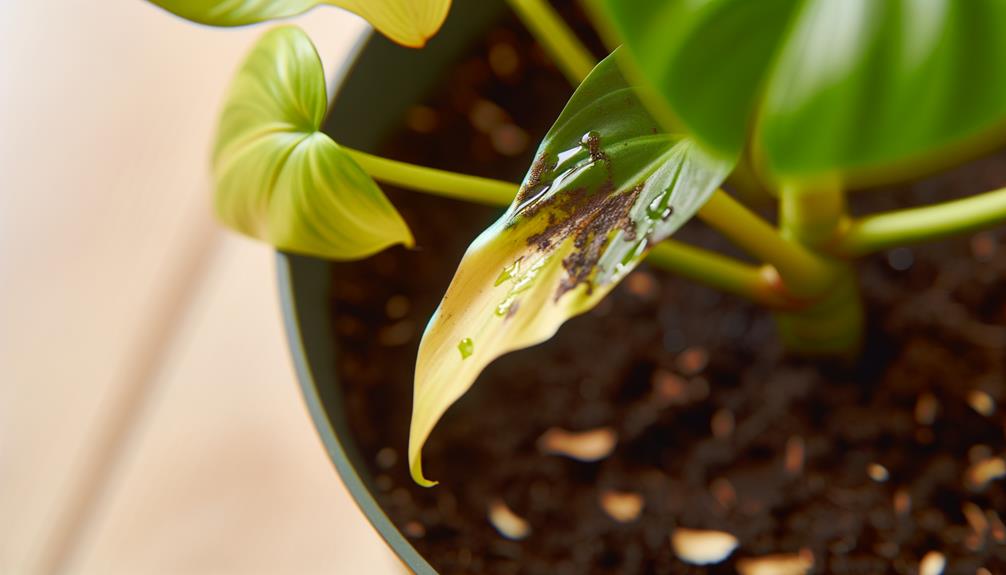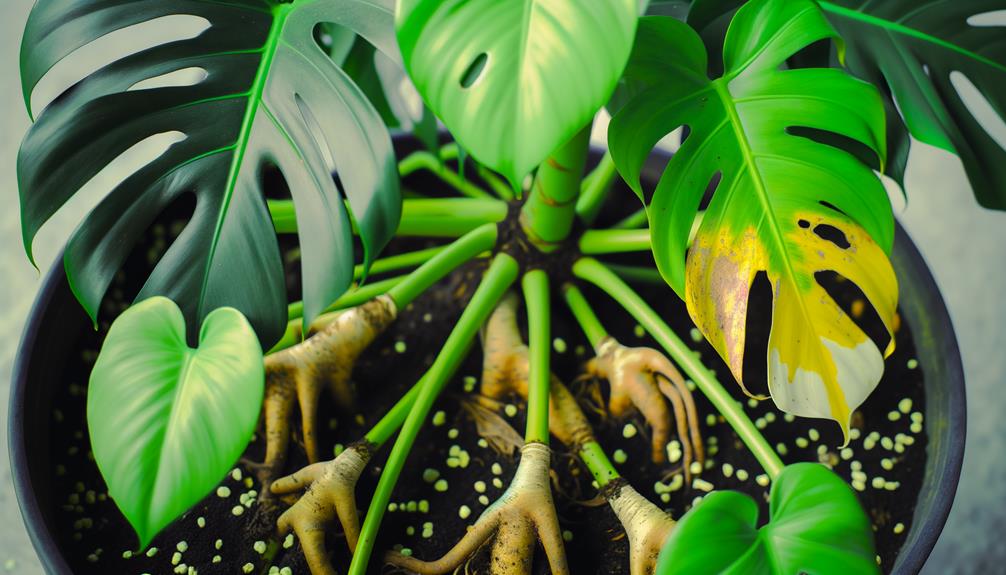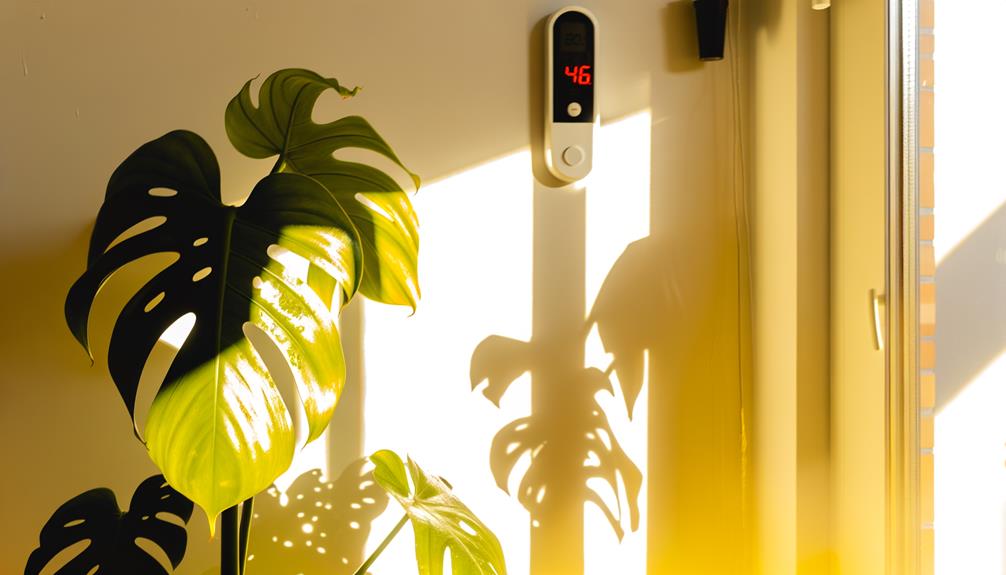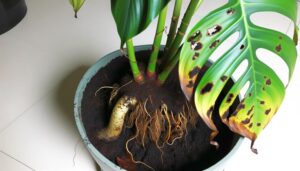Why Are the Small Leaves on My Monstera Turning Yellow?
The small leaves on your Monstera turning yellow likely result from overwatering, underwatering, or nutrient deficiencies. Overwatering causes root rot, restricting oxygen and nutrient absorption.
Underwatering hinders nutrient distribution. Make sure your pot has drainage holes and keep the soil moist but not waterlogged.
Nitrogen or magnesium deficiencies can also lead to yellowing. Poor lighting impairs photosynthesis, and insufficient light contributes to chlorosis.
Temperature stress outside the ideal range of 65-85°F damages cells, causing yellow leaves. By addressing these factors, you can restore your Monstera’s health and vibrancy.
For a more extensive solution, further exploration will benefit you.

Key Takeaways
- Overwatering leads to root rot, restricting nutrient uptake and causing yellow leaves.
- Inadequate watering results in insufficient nutrient transport, leading to yellowing leaves.
- Nutrient deficiencies, especially nitrogen and magnesium, can cause yellowing due to chlorosis.
- Poor lighting conditions hinder photosynthesis and result in yellow leaves.
- Temperature stress outside the ideal range (65-85°F) can damage cells and cause yellowing leaves.
Overwatering Issues

Overwatering is often the primary cause of yellow leaves on your Monstera, leading to root rot and nutrient deficiencies. When soil remains saturated, roots can’t access oxygen, causing them to decay. This decay impairs the plant’s ability to uptake essential nutrients like nitrogen, potassium, and magnesium, crucial for healthy foliage.
To prevent overwatering, make sure your Monstera’s pot has adequate drainage holes. Water only when the top inch of soil feels dry. Use a moisture meter for precision. Avoid letting the plant sit in water-filled saucers, which promotes an anaerobic environment harmful to roots.
Underwatering Concerns
Inadequate watering can lead to yellow leaves on your Monstera as the plant struggles to transport nutrients effectively. When the soil remains dry for extended periods, the roots can’t absorb essential minerals and water, causing stress.
This stress manifests as chlorosis, where leaves turn yellow due to reduced chlorophyll production. To address this, make sure your Monstera’s soil remains consistently moist but not waterlogged. Check soil moisture by inserting your finger an inch deep; if it feels dry, it’s time to water.
Utilize well-draining soil to prevent root rot while maintaining adequate hydration. Regularly monitor environmental factors like humidity and temperature, as they influence water needs. Remember, balancing moisture levels is crucial to your Monstera’s health and vibrant foliage.
Nutrient Deficiencies

When your Monstera’s leaves turn yellow, nutrient deficiencies could be a primary cause. A lack of nitrogen often results in older leaves yellowing, while insufficient magnesium can create yellowing between the leaf veins.
You should test your soil and adjust your fertilization routine to guarantee your plant receives a balanced supply of essential nutrients.
Lack of Nitrogen
A common cause of yellow leaves on a Monstera is nitrogen deficiency, manifesting as a gradual paling of the older leaves while new growth remains stunted and lackluster.
Nitrogen is essential for chlorophyll production, which gives leaves their green color and drives photosynthesis. When nitrogen is insufficient, plants redirect available nitrogen to newer leaves, leaving older foliage yellow.
To remedy this, apply a balanced, water-soluble fertilizer with an N-P-K ratio that favors nitrogen, such as 10-5-5. Ensure uniform distribution and follow the manufacturer’s guidelines to avoid over-fertilization.
Additionally, improve soil aeration and drainage to support nutrient uptake. Regularly monitor your Monstera for signs of recovery, adjusting care practices as necessary for best health.
Insufficient Magnesium
Just as nitrogen deficiency can fade your Monstera’s foliage, a lack of magnesium also poses a threat, appearing through interveinal chlorosis where the leaf veins stay green while the areas between them turn yellow.
Magnesium is an essential component of chlorophyll, the molecule responsible for photosynthesis. Without sufficient magnesium, your Monstera’s ability to produce energy diminishes, leading to yellowing leaves.
Test your soil to confirm magnesium levels. If lacking, consider applying a magnesium-rich fertilizer, such as Epsom salts (magnesium sulfate). Dissolve one tablespoon in a gallon of water and apply it to the soil. Ensure consistent watering practices, as overwatering or poor drainage can worsen nutrient imbalances.
Monitor your plant closely and adjust care routines as needed.
Poor Lighting Conditions
Insufficient lighting can cause chlorosis in Monstera leaves, leading to a yellowing effect that indicates the plant’s inability to photosynthesize effectively. Chloroplasts need sufficient light to convert carbon dioxide and water into glucose and oxygen.
When your Monstera doesn’t get enough light, it struggles to produce chlorophyll, resulting in pale or yellow leaves.
To rectify this, place your Monstera near an east or south-facing window where it can receive bright, indirect sunlight. If natural light is scarce, consider using a grow light with a full spectrum to mimic sunlight. Monitor the distance and duration to prevent leaf burn.
Temperature Stress

Temperature stress can greatly impact the health of your Monstera, leading to yellow leaves.
Maintain an ideal temperature range of 65-85°F, as deviations can cause cellular damage.
Minimize temperature fluctuations by positioning the plant away from heating and cooling systems, which can create unstable environments.
Ideal Temperature Range
Maintaining an ideal temperature range of 65-85°F is essential for Monstera plants, as deviations can lead to stress and yellowing leaves. Monstera species thrive in warm, stable environments.
Temperatures below 65°F can slow metabolic processes, reducing chlorophyll production and causing yellowing. Conversely, temperatures above 85°F can increase transpiration rates, leading to water stress and nutrient deficiencies, which manifest as yellow leaves.
To maintain this range, position your Monstera away from drafty windows, heating vents, and direct air conditioning. Use a room thermometer to monitor the ambient temperature. If necessary, employ a humidifier or space heater to stabilize conditions.
Ensuring these parameters will help your Monstera maintain its lush, green foliage and overall health.
Temperature Fluctuations
Frequent temperature fluctuations can place significant stress on Monstera plants, resulting in yellowing leaves as a primary symptom. You should aim to maintain a consistent temperature to guarantee your Monstera’s health. Sudden changes disrupt the plant’s physiological processes, making it more susceptible to stress and nutrient deficiencies.
Consider the following practical advice:
- Monitor indoor temperatures: Use a reliable thermometer to keep track of temperature variations.
- Avoid drafts and vents: Place your Monstera away from areas with frequent air movement.
- Use insulating materials: Curtains or blinds can help stabilize room temperature.
Heating and Cooling Systems
To lessen temperature stress caused by heating and cooling systems, secure your Monstera is positioned away from direct airflow sources like radiators or air conditioners. Sudden temperature shifts can cause the small leaves to turn yellow by disrupting cellular functions and photosynthesis.
Maintain a stable environment with a temperature range between 65°F and 75°F, which is ideal for Monstera growth. Utilize a room thermometer to monitor ambient conditions closely. If you use a heating system, consider using a humidifier to counteract dry air, as humidity levels should stay between 40% and 60%.
Consistent exposure to these conditions guarantees that your Monstera avoids stress responses, promoting healthy, vibrant foliage.
Pest Infestations
Pest infestations, particularly from spider mites, aphids, and scale insects, can cause yellowing leaves on a Monstera by sucking the plant’s sap and introducing harmful toxins. These pests not only deplete essential nutrients but also compromise the plant’s overall health.
To manage pest infestations effectively:
- Inspect regularly: Frequently check the undersides of leaves and stems for signs of pests.
- Isolate affected plants: Separate infested plants to prevent the spread of pests to healthy ones.
- Use appropriate treatments: Apply insecticidal soap, neem oil, or horticultural oil to eliminate pests without harming the plant.
Identifying and treating pest infestations promptly is vital. Regular monitoring and immediate action can help maintain your Monstera’s health and prevent yellowing leaves.
Root Health Problems

Root health problems, often stemming from overwatering or poor drainage, can lead to yellowing leaves on your Monstera by causing root rot and nutrient deficiencies. Excess water creates anaerobic conditions, promoting pathogenic fungi that deteriorate root structures. You’ll notice a foul smell and mushy, darkened roots.
To address this issue, make sure your pot has drainage holes and use well-aerated soil. Avoid letting the plant sit in water; only water when the top inch of soil feels dry. If you suspect root rot, trim affected roots and repot in fresh soil.
Nutrient uptake can also be compromised. Utilize a balanced, water-soluble fertilizer during the growing season to maintain nutrient levels, supporting healthy leaf coloration.
Should I Cut Off Yellow Leaves Monstera?
You can cut off yellow leaves from your Monstera plant, but it depends on the situation:
- Aesthetic Purposes: Removing yellow leaves can improve the plant’s appearance. It’s not harmful to the plant and can keep it looking tidy.
- Disease Prevention: If the yellowing is due to a fungal infection, removing the affected leaves can prevent the disease from spreading to healthy parts of the plant.
- Nutrient Reabsorption: If the yellowing is due to natural aging or nutrient reabsorption, it might be better to leave the leaves until they are completely yellow and can be easily pulled off. This allows the plant to reabsorb nutrients from the dying leaves.
- Root Rot: If yellowing is caused by root rot, it’s crucial to address the root issue first. Removing yellow leaves in this case can help, but fixing the underlying problem is more important.
In summary, while cutting off yellow leaves can be beneficial for aesthetic and health reasons, it’s essential to understand the cause of yellowing to take appropriate action.
Conclusion
Imagine your Monstera with vibrant, lush leaves basking in the morning sunlight. Achieving this is within your grasp.
By avoiding overwatering, ensuring consistent hydration, providing balanced nutrients, optimizing light, maintaining stable temperatures, and keeping pests at bay, you’ll foster a thriving plant.
Don’t forget to check the roots for health. With these steps, your Monstera will flourish, transforming your space into a green oasis, full of life and natural beauty.






